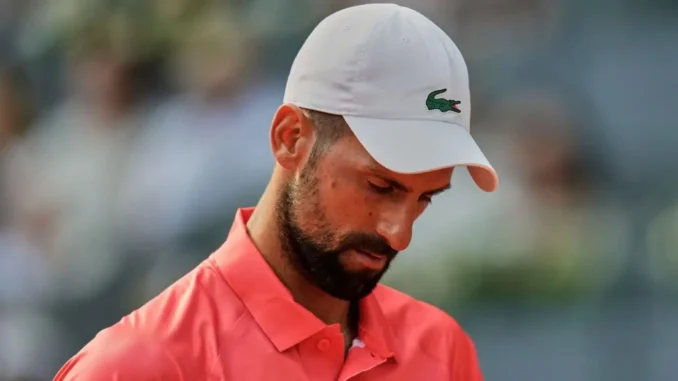
Novak Djokovic, the tennis titan with 24 Grand Slam titles, has long been synonymous with invincibility, his aura intimidating opponents before a single ball is struck. Yet, in 2025, whispers of a fading mystique have grown louder, with the Serbian star enduring a challenging season marked by early exits and a noticeable dip in form. As he prepares for the Italian Open, analysts and former players, including Alex Corretja, point to one critical factor that should not be underestimated: the physical toll of aging on a player renowned for his superhuman fitness. At 37, Djokovic’s struggles signal a natural, if reluctant, shift in a career that has redefined tennis.
Djokovic’s 2025 season has been uncharacteristically turbulent. Despite reaching the Australian Open semifinals, a hamstring injury forced him to retire against Alexander Zverev, ending his bid for a 25th major. A Miami Open final loss to Jakub Mensik and a withdrawal from the Italian Open before his fourth-round match against Alejandro Tabilo underscored his inconsistency. His clay-court campaign has been particularly rocky, with early exits in Monte-Carlo and Madrid. “I’m not playing my best tennis this year,” Djokovic admitted after a recent defeat, his candor reflecting a rare vulnerability. Social media buzz on X has amplified the narrative, with fans noting that younger players like Carlos Alcaraz and Jannik Sinner no longer seem daunted by the Djokovic aura that once paralyzed opponents.
Corretja, a former world No. 2, pinpointed physical decline as a pivotal reason for Djokovic’s struggles. “You cannot underestimate how much effort Novak has put into his physical condition to be ready for battle,” he said. “He’s been like a machine, but at some point, the body doesn’t respond the same way.” Djokovic’s game, built on relentless defense, elastic movement, and endurance, relies heavily on peak physicality. His ability to outlast opponents in grueling five-setters—evidenced by his 38–11 career record in such matches—has been a hallmark. Yet, recent matches reveal signs of fatigue, with Djokovic winning just 60% of points in deciding sets this year, a drop from his career average. “When you’re not at 100%, you give a chance to the youngsters,” Corretja noted, highlighting how players like Sinner, who bested Djokovic in Shanghai, capitalize on any weakness.
The mental toll of maintaining supremacy also looms large. Djokovic, who briefly coached by Andy Murray in 2025 before parting ways, has spoken of the challenge of staying motivated after achieving unparalleled success. “It’s hard to find new goals when you’ve won everything,” he said, echoing sentiments from his 2024 season, where he went title-less for the first time since 2017. The rise of a fearless new generation, including Alcaraz, Sinner, and Jack Draper, has intensified the pressure. Unlike the “Big Three” era, where Djokovic, Rafael Nadal, and Roger Federer dominated, today’s field is deeper, with 11 players under 25 ranked in the top 30. “The young guys are playing without fear,” Corretja observed. “They see Novak as human now.”
Despite the setbacks, Djokovic remains a formidable force. His 6–3 record against top-10 players in 2025 and a third-round win over Holger Rune in Rome demonstrate his enduring class. As he eyes the French Open, where he’s a three-time champion, Djokovic is focused on rediscovering his spark. “I’m working on getting back to my best,” he said, his resolve unshaken. While his aura may be dimming, his legacy—99 career titles, 428 weeks at No. 1—ensures he’ll never be underestimated. For now, the tennis world watches, wondering if Djokovic can defy time once more or if the baton is truly passing to the next generation.
Leave a Reply